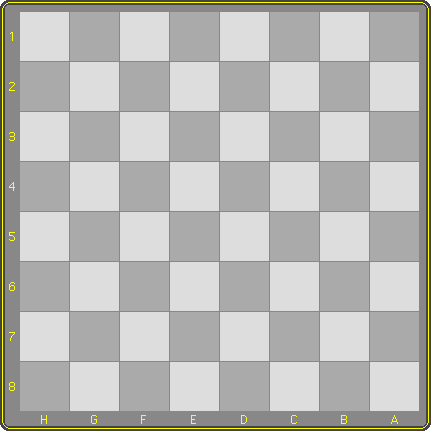Page 2 of 2
Object
If a player has no legal move he loses the game. This may come about either by being eliminated or being blocked completely.
 | Capture has precedence over a non-capturing move. If the player to move has no capture to make, he must move a man or a king. Moving a piece - promotion A man moves one square forward, either straight or diagonally. The diagonal move of a man is the only diagonal move in the game. All other moves, whether capturing or non-capturing, are orthogonal only. If a man ends its move on the opponent's backrank, it promotes to king. This marks the end of the move. A king moves any number of unobstructed squares horizontally or vertically, like the rook in Chess. Kings may not move diagonally. An important detail concerning promotion and capture has to be addressed. Be it first established that completing a capture always has priority! Since men capture by jumping opponent's pieces forward, sideways and backward, a situation may arise where a man, in the course of a capture, visits the backrank without ending its move on it. In that situation, the man is not promoted. |
All capture is orthogonal only. Capture is compulsory and has precedence over a non-capturing move. Majority capture precedes over a capture of less pieces.
- If a man is on a particular rank or file, and next to it is a square occupied by an opponent's piece, then the man captures the piece by jumping over it to the square immediately beyond, which must be vacant for the capture to take place.
If the man can proceed in a similar way in another direction, except a 180 degrees turn, it must do so, taking care beforehand to establish the route that brings the maximum number of captured pieces. A captured king counts as one piece.
If there's more than one way to meet this criterion, the player is free to choose. - A king looks along open ranks or files. If it sees, at any distance, an opponent's piece and immediately beyond one or more subsequent vacant squares, it captures by jumping the piece and landing on one of these squares.
A king is subject to the same rules regarding majority capture: if it can proceed in a similar way in another direction, except a 180 degrees turn, it must do so, taking care beforehand to establish the route that brings maximum number of captured pieces. A captured king counts as one piece.
If there are more than one way to meet this criterion, the player is free to choose.
The expression '...it captures by jumping the piece and landing on one of these squares' does not necessarily imply choice. In fact, during the capture the king will usually have no choice because it is subject to majority capture. After jumping the last piece it may have choice where to land.
- After - and only after - a multiple capture has taken its complete course, the captured pieces are removed from play.
- In the course of a multiple capture a piece may visit the same square more than once, but it may not capture the same piece more than once.
| Both rules are illustrated simultaneously in the coup turc: The final capture of the king stops at e3 because the man on d3 has already been captured, while the man on e2 is still covered by the already captured man on e1! Draws
External links Croda © Ljuban Dedić | ||||||






